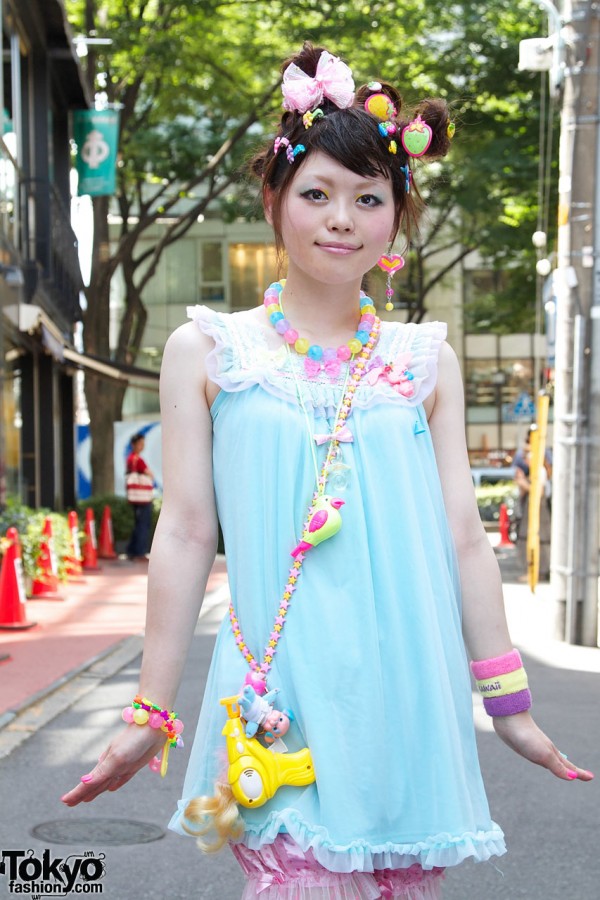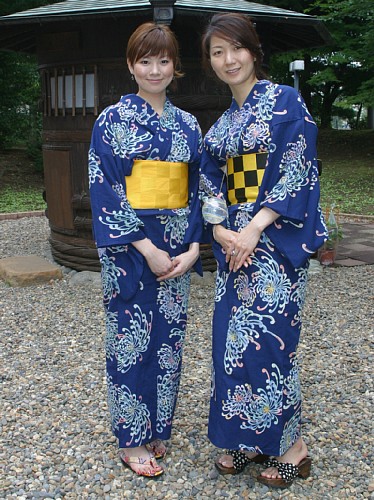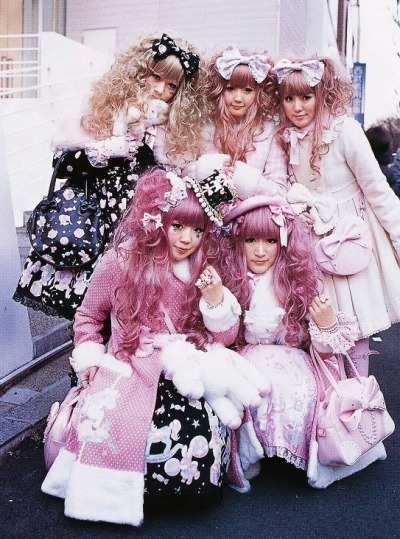Kimono
The first thing that comes to mind when thinking of Japanese clothing is the Kimono, which literally translated simply means 'clothing'. This traditional outfit is one of the most recognizable parts of Japanese culture. Although it is not commonly in use any more, you can still spot Japanese women wearing kimono from time to time, but in most cases it indicates some formal meeting, religious holidays or family ceremonies, such as weddings. There are many types of kimono, each worn according to the persons age, marital status, season or event.
The other type of traditional Japanese Kimono is called Yukata. This is a summer casual kimono worn by both men and women. For more formal occasions this kimono type can be accompanied by wooden sandals, called geta and obi belt wrapped around the waist. Yukata is lightweight cotton kimono normally with very brightly colored designs on it. It is mostly worn for summer festivals and religious ceremonies such as Bon-Odori.
http://web-japan.org/kidsweb/virtual/kimono/kimono01.html
http://library.thinkquest.org/04oct/00327/jtimeline.html
Lolita , gothic Lolita, sweet Lolita
This is a youth fashion among Japanese teenagers and young women. It emphasizes Victorian-style girl's clothing and often aims to imitate the look of Victorian porcelain dolls. Gothloli's name and origin is a combination of lolita fashion, appearing deliberately cute to the point of looking childish, and certain styles found within gothic fashion. The style started as a youth subculture sometime around 1997-98 and became a well-established genre available in various boutiques and some major department stores by around 2001.Gothic Lolita is one of the subcategories of the Lolita look. Other categories include "Classic Lolita" (more traditional, light-coloured, also more mature-looking) and "Sweet Lolita" (childish pastel-coloured clothes, lots of lace and ribbons).
http://www.lolitafashion.org/what_is_lolita.html

Kawaii And Decora
Kawaii itself means very "cute", "adorable", and "pretty".
this fashion consists of very bright colors and many accessories. that means hair clips and lots and lots of bows man.
 Decora also known as "Decoration" is a japanese style adopted mainly by young japanese girls. Decora consists of bright colors and hair clips with bows. Lots of layering and colorful accessories are used in Decora. The accessories include plastic and furry toys and jewelry, which stick together and make noise as the wearer moves.
Decora also known as "Decoration" is a japanese style adopted mainly by young japanese girls. Decora consists of bright colors and hair clips with bows. Lots of layering and colorful accessories are used in Decora. The accessories include plastic and furry toys and jewelry, which stick together and make noise as the wearer moves.
The style is sometimes mistakenly called "Fruits style" by people that are not from Japan.
for more:
Harajuku
A narrow street packed with young fashionable people and lined with fashion boutiques and cafes. This is definitely the place to be seen if you are young Tokyoite, but well worth visiting as a tourist. Takeshita-dori represents the cutting edge of fashion in Tokyo where you can see all the latest in Japanese street fashion and then buy in the boutiques.
Harajuku Girls is a term to describe women and teenaged girls in Harajuku(Tokyo Japan) who wear a style of clothing that originated in the street culture of major cities in Japan, i.e. Tokyo and Osaka. The "Harajuku style," named for the Harajuku district of Tokyo, combines a wide range of diverse influences, and is also known as "Fruits Fashion" by followers of Fruits Magazine. The terms "Harajuku Girls" and "Fruits" are not used by the Japanese to describe themselves.
Visual kei
Visual Kei refers to a movement among Japanese rock (jrock) musicians and is characterized by the use of elaborate costumes, eccentric, looks and hairstyles. The Visual Kei look usually involves striking make-up,
The "kei" in Visual Kei is japanese for style of type, meaning "visual style music" The music ranges from eighties goth rock, to heavy metal to punk and usually some combo of the three. Most bands are indie but a not many make it to major labels such as Malice Mizer, Raphael, & Dir En Grey.
Visual Kei has influenced Harajuku style fashion, especially those who gather on Jingu Bashi - a pedestrian bridge connecting the bustling Harajuku district with Meiji Shrine.
Cosplay
Cosplay is an abbreviation of Costume Play. It is a Japanese subculture based on dressing like characters from manga, anime,and
In Japan, "cosplay" as a hobby is usually an end unto itself. Cosplay can be seen at public events and shows as well as at dedicated cosplay parties.






this is what we are talking about in our first meeting people. also we need one member to become an expert in each category for the J fashion show we are tiring to host
ReplyDeleteIf it is all the better and in case we lose some members, I can become a total expert in kimonos and ukatas, seeing the fact that I own both of them and kindof already are an expert..... Legitimately speaking, I love the entirety of your post! The information is so detailed that even grandma might like it but im not sure so I won't try.
ReplyDeletei think we will lose members since no one seems to care and have made that clear by shoving it in my face. i am very open to ideas its just no one seems to give a damn and suggest one already.
ReplyDeleteThis is awsome
ReplyDelete